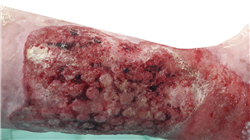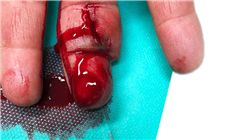University certificate
Scientific endorser

The world's largest faculty of nursing”
Introduction to the Program
Thanks to this 100% online Professional master’s degree, you will overcome the challenges associated with the treatment of wounds and significantly improve the quality of life of individuals”

A recent report published by the World Health Organization reveals that Pressure Ulcers are a common complication in hospitalized patients, with an estimated prevalence of 10% in Intensive Care Units. In this situation, effective prevention and management of these conditions not only improve the quality of life of patients, but also significantly reduce the costs associated with prolonged treatment. In this scenario, nursing professionals play a key role in this area, ranging from assessment or diagnosis to the implementation of treatment plans and patient education. Therefore, they have the responsibility to acquire advanced competencies to provide highly personalized care according to the needs of the users.
In this context, TECH implements a pioneering and revolutionary Professional master’s degree in TECH. Designed by renowned experts in this area, the academic itinerary will focus on the most effective strategies for the management of wounds, skin lesions, burns and traumatic wounds. In addition, the agenda will delve into the management of complications related to the treatment of Venous Ulcers. During the course of the program, graduates will develop advanced competencies to diagnose wounds, identifying their etiology and any potential complications. Thanks to this, professionals will execute individualized treatment plans based on the clinical evaluation of patients.
Moreover, regarding the methodology of this program, TECH uses its innovative Relearning teaching system. This method consists of the progressive reiteration of key concepts to ensure that graduates achieve a full understanding of the content. In addition, for access to all the teaching resources, the only thing they will need is an electronic device with an Internet connection (such as their cell phone, tablet or computer). Therefore, they will enter the Virtual Campus and will enjoy a highly dynamic learning experience.
A high-intensity program that will significantly increase the quality of your care for patients with skin lesions”
This Professional master’s degree in Wound Care for Nursing contains the most complete and up-to-date scientific program on the market. The most important features include:
- The development of case studies presented by experts in Wound Care for Nursing
- The graphic, schematic and eminently practical contents with which it is conceived gather scientific and practical information on those disciplines that are indispensable for professional practice
- Practical exercises where self-assessment can be used to improve learning
- Its special emphasis on innovative methodologies
- Theoretical lessons, questions to the expert, debate forums on controversial topics, and individual reflection assignments
- Content that is accessible from any fixed or portable device with an Internet connection
You will deepen in the care of Geriatric Patients with Arterial Ulcers, which will allow you to provide excellent care”
The program includes in its teaching staff professionals from the sector who bring to this program the experience of their work, as well as recognized specialists from leading societies and prestigious universities.
The multimedia content, developed with the latest educational technology, will provide the professional with situated and contextual learning, i.e., a simulated environment that will provide immersive education programmed to learn in real situations.
This program is designed around Problem-Based Learning, whereby the professional must try to solve the different professional practice situations that arise during the course. For this purpose, the student will be assisted by an innovative interactive video system created by renowned and experienced experts
You will implement in your clinical practice the most innovative pharmacological strategies to alleviate the pain caused by diabetic foot"

TECH's disruptive Relearning method will allow you to consolidate the key concepts of the syllabus quickly and efficiently"
Why study at TECH?
TECH is the world’s largest online university. With an impressive catalog of more than 14,000 university programs available in 11 languages, it is positioned as a leader in employability, with a 99% job placement rate. In addition, it relies on an enormous faculty of more than 6,000 professors of the highest international renown.

Study at the world's largest online university and guarantee your professional success. The future starts at TECH”
The world’s best online university according to FORBES
The prestigious Forbes magazine, specialized in business and finance, has highlighted TECH as “the world's best online university” This is what they have recently stated in an article in their digital edition in which they echo the success story of this institution, “thanks to the academic offer it provides, the selection of its teaching staff, and an innovative learning method aimed at educating the professionals of the future”
A revolutionary study method, a cutting-edge faculty and a practical focus: the key to TECH's success.
The most complete study plans on the university scene
TECH offers the most complete study plans on the university scene, with syllabuses that cover fundamental concepts and, at the same time, the main scientific advances in their specific scientific areas. In addition, these programs are continuously being updated to guarantee students the academic vanguard and the most in-demand professional skills. In this way, the university's qualifications provide its graduates with a significant advantage to propel their careers to success.
TECH offers the most comprehensive and intensive study plans on the current university scene.
A world-class teaching staff
TECH's teaching staff is made up of more than 6,000 professors with the highest international recognition. Professors, researchers and top executives of multinational companies, including Isaiah Covington, performance coach of the Boston Celtics; Magda Romanska, principal investigator at Harvard MetaLAB; Ignacio Wistumba, chairman of the department of translational molecular pathology at MD Anderson Cancer Center; and D.W. Pine, creative director of TIME magazine, among others.
Internationally renowned experts, specialized in different branches of Health, Technology, Communication and Business, form part of the TECH faculty.
A unique learning method
TECH is the first university to use Relearning in all its programs. It is the best online learning methodology, accredited with international teaching quality certifications, provided by prestigious educational agencies. In addition, this disruptive educational model is complemented with the “Case Method”, thereby setting up a unique online teaching strategy. Innovative teaching resources are also implemented, including detailed videos, infographics and interactive summaries.
TECH combines Relearning and the Case Method in all its university programs to guarantee excellent theoretical and practical learning, studying whenever and wherever you want.
The world's largest online university
TECH is the world’s largest online university. We are the largest educational institution, with the best and widest online educational catalog, one hundred percent online and covering the vast majority of areas of knowledge. We offer a large selection of our own degrees and accredited online undergraduate and postgraduate degrees. In total, more than 14,000 university degrees, in eleven different languages, make us the largest educational largest in the world.
TECH has the world's most extensive catalog of academic and official programs, available in more than 11 languages.
Google Premier Partner
The American technology giant has awarded TECH the Google Google Premier Partner badge. This award, which is only available to 3% of the world's companies, highlights the efficient, flexible and tailored experience that this university provides to students. The recognition as a Google Premier Partner not only accredits the maximum rigor, performance and investment in TECH's digital infrastructures, but also places this university as one of the world's leading technology companies.
Google has positioned TECH in the top 3% of the world's most important technology companies by awarding it its Google Premier Partner badge.
The official online university of the NBA
TECH is the official online university of the NBA. Thanks to our agreement with the biggest league in basketball, we offer our students exclusive university programs, as well as a wide variety of educational resources focused on the business of the league and other areas of the sports industry. Each program is made up of a uniquely designed syllabus and features exceptional guest hosts: professionals with a distinguished sports background who will offer their expertise on the most relevant topics.
TECH has been selected by the NBA, the world's top basketball league, as its official online university.
The top-rated university by its students
Students have positioned TECH as the world's top-rated university on the main review websites, with a highest rating of 4.9 out of 5, obtained from more than 1,000 reviews. These results consolidate TECH as the benchmark university institution at an international level, reflecting the excellence and positive impact of its educational model.” reflecting the excellence and positive impact of its educational model.”
TECH is the world’s top-rated university by its students.
Leaders in employability
TECH has managed to become the leading university in employability. 99% of its students obtain jobs in the academic field they have studied, within one year of completing any of the university's programs. A similar number achieve immediate career enhancement. All this thanks to a study methodology that bases its effectiveness on the acquisition of practical skills, which are absolutely necessary for professional development.
99% of TECH graduates find a job within a year of completing their studies.
Professional Master's Degree in Wound Care for Nursing
In nursing, wound care and treatment is an essential competency that requires advanced knowledge and specialized skills. TECH Global University of Technology presents the Professional Master's Degree in Wound Care for Nursing, an online classroom program designed to specialize professionals in the most advanced wound management techniques. This Professional Master's Degree is aimed at nurses looking to hone their skills and elevate their clinical practice to the next level. The Master's degree offers a comprehensive and specialized education in the management of acute and chronic wounds, surgical wounds, and pressure wounds. Through a rigorous and detailed approach, students will learn best practices for wound healing, accurate assessment and diagnosis of different types of wounds, as well as effective infection management and the correct application of dressings and bandages. Course participants will benefit from the expertise of a teaching team composed of experts in the field of nursing and wound care, who will share their knowledge and practical experience.
Study an online Professional Master's Degree in wound care
One of the highlights of the Professional Master's Degree in Wound Care for Nursing is its focus on the use of advanced technologies and evidence-based methodologies. Students will learn to use state-of-the-art diagnostic and treatment tools, as well as implement wound care protocols based on the latest research. This ensures that graduates of the program are up to date with trends and advances in wound care, preparing them to provide the best possible care for their patients. The flexibility of online classes allows nursing professionals to balance their studies with their work and personal responsibilities. In addition, you will have at your disposal an accessible and easy-to-use online learning platform that allows students to advance at their own pace and access high-quality educational resources anytime, anywhere. Join TECH Global University of Technology and transform your career in nursing.







